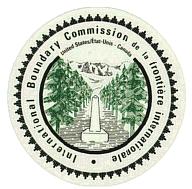

|
While Canada and the United States both boast their world's longest undefended border title today, final placement of the border has not been without difficulties. Most squirmishes about today are about what goes across the border instead of where the border actually is located. Read on below to discover the history behind some of the locations of the border. |
|
International Boundary Commission
Boundary HistoryThe story of defining the boundary starts with the Treaty of Paris in 1783, which described the border from the Atlantic Ocean to the Prairies between British North America and the American states that had gained independence seven years earlier. It was the basis for discussions about the boundary for 60 years after it was signed and disagreement over the description in the treaty continued until the Webster -Ashburton Treaty of 1842, in which both countries finally agreed to the boundary location in this area. The boundary from the source of the St. Croix River to the St. Lawrence was surveyed from 1843 to 1847, and through the Great Lakes from 1817 to 1824.The Jay Treaty of 1794 created the first International Boundary Commission. Over the succeding years Canada and the United States appointed a series of temporary boundary commissions to oversee boundary surveys, mapping and general maintenance. By the early 1990's the physical definition of the boundary was largely completed. With the Convention of 1818, the border was defined from Lake of the Woods to the Stony (Rocky) Mountains, establishing a frontier for land settlement across the western part of North America. The boundary survey from Lake of the Woods to the Red River Settlement was completed in the winters of 1872 and 1873 and the balance to the mountains in the summers of 1873 and 1874. The expansionist cry,"54-40 or fight", of the Democrats, brought their man, James Knox Polk, to the presidency in 1844 best indicates the atmosphere in which the boundary from the mountains to the Pacific was contested in the Oregon boundary dispute. By agreement, the territory had been open to both British and American subjects leaving a situation ripe for conflicting claims by settler groups, encounters between imperial and national interests and political intrigue. Basically the United States claimed the territory up to Russian Alaska (54o 40' N) and the British claimed the land down to the Columbia River. The Oregon Treaty signed in 1846 extended the boundary along the 49th parallel to the coast and through the Straits of Georgia and Juan de Fuca to the Pacific Ocean. Ownership of the San Juan Archipelago was established in 1873 in an arbitral award. This region was surveyed from 1856 to 1861 and the Strait of Georgia in 1906. In 1903, a tribunal of three Americans, two Canadians and a representative of Great Britain, established the Alaska panhandle boundary. This section of the Alaska boundary was surveyed from 1904 to 1914. Under the Convention of 1906 the balance of the border, defined by earlier treaties as along the 141st meridian, was surveyed from 1907 to 1913. In 1925 the two countries created a permanent International Boundary Commission to maintain the boundary. The modern IBC is reponsible for:inspecting the boundary line; repairing or replacing damaged boundary markers; maintaining a clear 6 metre vista through the brush and trees;and helping to resolve disputes along the border as they arise. The Legal AspectThe International Boundary Commission is responsible for determining the position of any point on the boundary necessary to settle questions that might arise between the two governments. For example, law officers preparing to make arrests for smuggling or drug trafficking in the border area must be sure that their suspects are on national territory. Also, if ships collide in the St. Lawrence or on the Great Lakes, their position must be accurately known to determine where the legal case will be heard.Such legal teasers were common during the 140 years it took to establish the present boundary location. In fact, the following examples became major issues in redefining the boundary from a general description in treaty papers to a surveyed and marked line on the ground. In 1825, an American citizen symbolically raised an American flag on the north shore of the Saint John River, and then declared that he would defend its honour. Legally, could he have been tried for treason in a British court when ownership of the territory was in dispute? In 1859, an American citizen on San Juan Island shot a pig - the property of the Hudson's Bay Company. Could law enforcers take him before a magistrate in Victoria and make him pay damages under British law? In 1845, an American citizen made a claim on alleged land of the Hudson's Bay Company north of the Columbia River. Was this claim to be honored in territory already claimed by the British? Attempts to answer such questions arose as settlers moved across North America. They resulted in clashes between the settlers, land claiming prompted by national pride and imperial design, and negotiations that sometimes approached open hostility. But in the end, diplomacy prevailed and the boundary was accurately described and marked on the ground, ending such problems. British Columbia / Yukon - Alaska
 Nova Scotia - Maine
|
